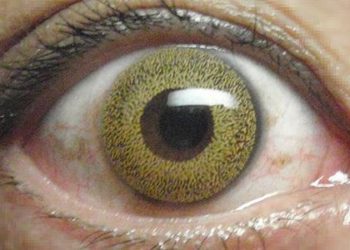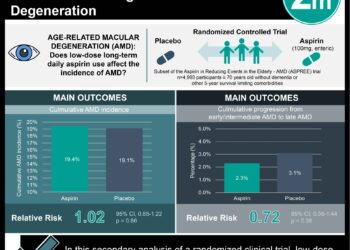Novel anti-VEGF agent provides additional benefit when combined with ranibizumab for neovascular age-related macular degeneration
1. In a phase 2 randomized trial, intravitreal injection with both ranibizumab and OPT-302, a VEGF-C and -D inhibitor, led to greater improvement in visual acuity at 24 weeks than ranibizumab alone in patients with neovascular age-related macular degeneration (AMD).
2. OPT-302 was not associated with increased risk of adverse events.
Evidence Rating Level: 1 (Excellent)
Study Rundown: Intravitreal injection of medication inhibiting vascular endothelial growth factor (VEGF) is the cornerstone of treatment for neovascular, or wet, age-related macular degeneration (AMD). Anti-VEGF agents in current use, including ranibizumab (Lucentis), target the VEGF-A molecule, while aflibercept (Eylea) targets VEGF-B. OPT-302, a recombinant fusion protein, is the first agent to target VEGF-C and VEGF-D. In this phase 2b, multicenter trial, 365 patients with wet AMD were randomized to receive OPT-302 in one of two doses or sham injections, in addition to ranibizumab therapy. At week 24, subjects receiving 2 mg OPT-302, but not 0.5 mg, had a statistically significant improvement in best corrected visual acuity (BCVA) over baseline compared to controls. This indicates that therapy with OPT-302 and ranibizumab was superior to ranibizumab alone. A lower proportion, 18.5%, of patients receiving 2 mg OPT-302 had subretinal fluid at 24 weeks compared to 29.3% in the control group, although this difference did not reach statistical significance. Rates of adverse events were similar between groups. This trial provides strong evidence of additional benefit from the novel agent OPT-302 and suggests that higher dosing at 2 mg is appropriate and safe. In vitro studies have indicated the potential of VEGF-C and -D inhibition to prevent anti-angiogenic signaling beyond the inhibitory effect of anti-VEGF-A or -B agents alone, as VEGF-C and -D are the only ligands for some VEGF receptors. Although study of long-term outcomes will be particularly important given the cost and inconvenience of giving two recurrent injections, this study bears out the concept in the clinical setting.
Click to read the study in Ophthalmology
Relevant Reading: Current and upcoming anti-VEGF therapies and dosing strategies for the treatment of neovascular AMD: A comparative review
In-Depth [randomized controlled trial]: In this parallel-group, double-masked trial, patients 50 years or older with wet AMD involving the fovea who had not previously received treatment were enrolled between 2017 and 2018. Participants were randomized in a 1:1:1 ratio to receive 0.5 mg OPT-302, 2 mg OPT-302, or sham. Six intravitreal injections were administered every 4 weeks to all participants, and were administered sequentially with 0.5 mg ranibizumab. In the primary, modified intention-to-treat analysis, the mean change in BCVA was +14.2 ETDRS letters with a standard deviation of 11.61, compared to +10.8 ± 11.52 letters for the sham group (p=0.01) and +9.44 ± 11.32 for the 0.5 mg group. In the 2 mg OPT-302 group, 45% of patients gained at least 15 ETDRS letters, compared to 33% in the 0.5 mg group and 40.5% in the sham group, although this difference was not statistically significant. In the OPT-302 groups, 28.3% and 29.8% of patients had ocular adverse events related to injection, such as eye pain, conjunctival hemorrhage, and increased intraocular pressure compared to 24.8% patients in the sham group receiving only one injection.
Image: PD
©2023 2 Minute Medicine, Inc. All rights reserved. No works may be reproduced without expressed written consent from 2 Minute Medicine, Inc. Inquire about licensing here. No article should be construed as medical advice and is not intended as such by the authors or by 2 Minute Medicine, Inc.






